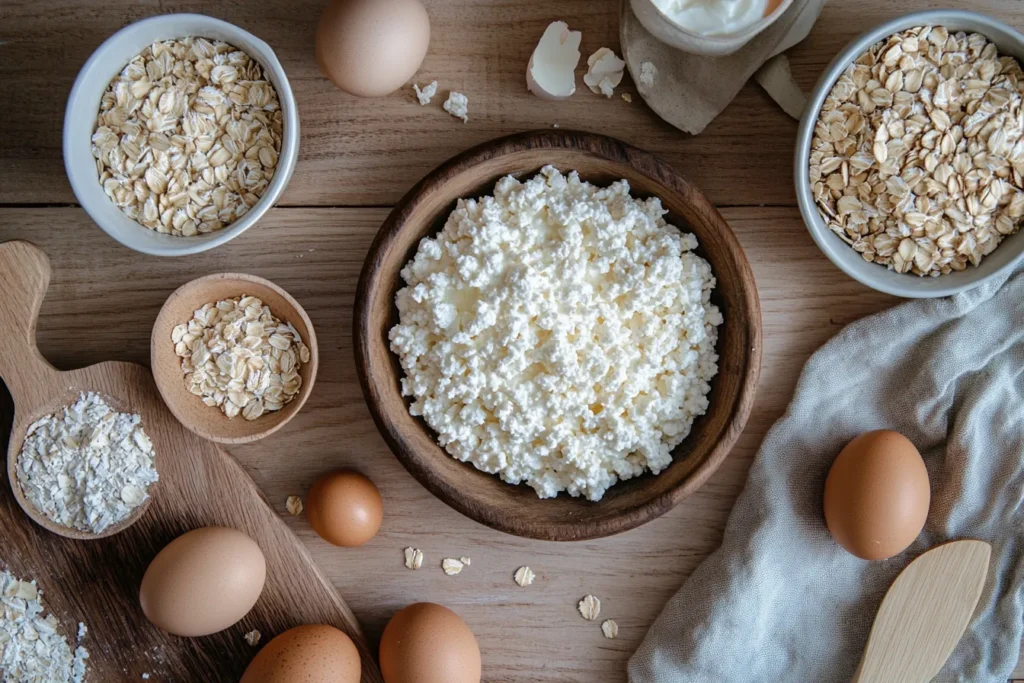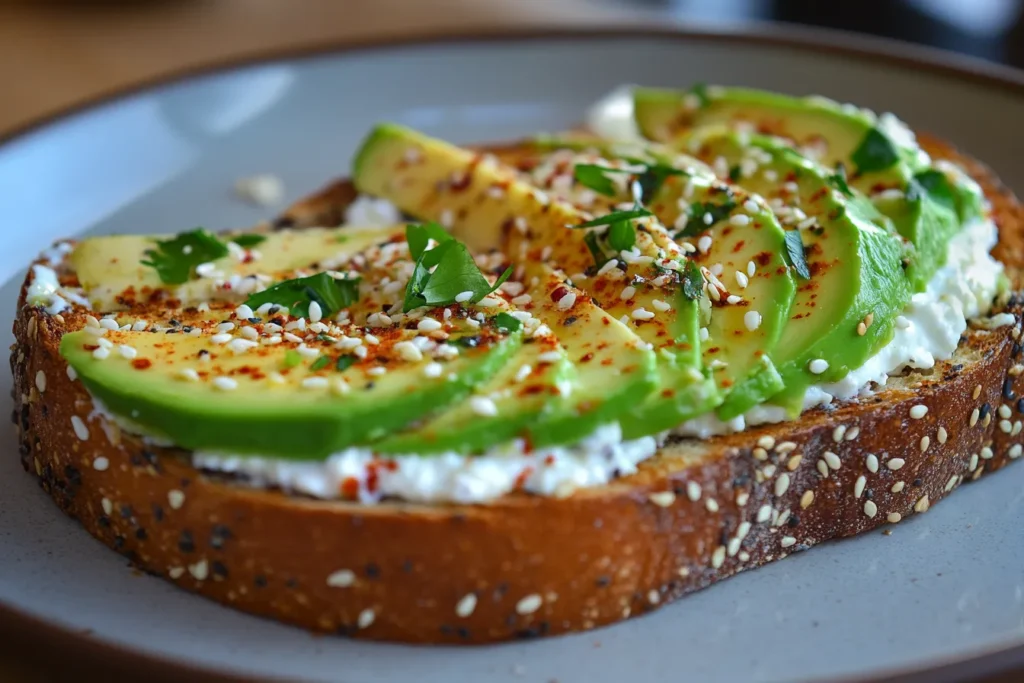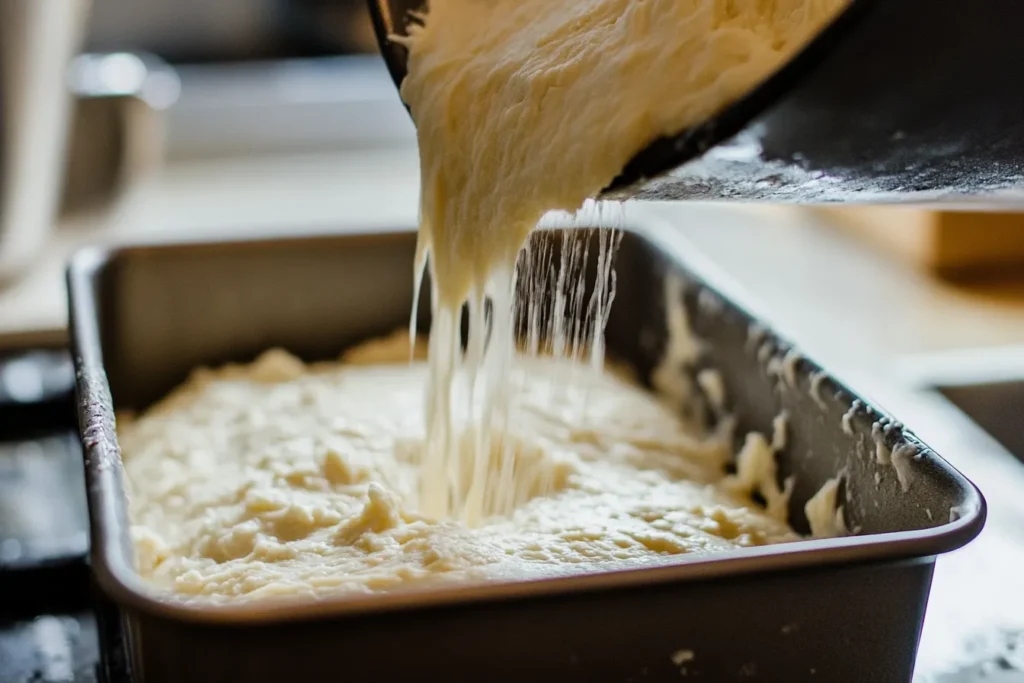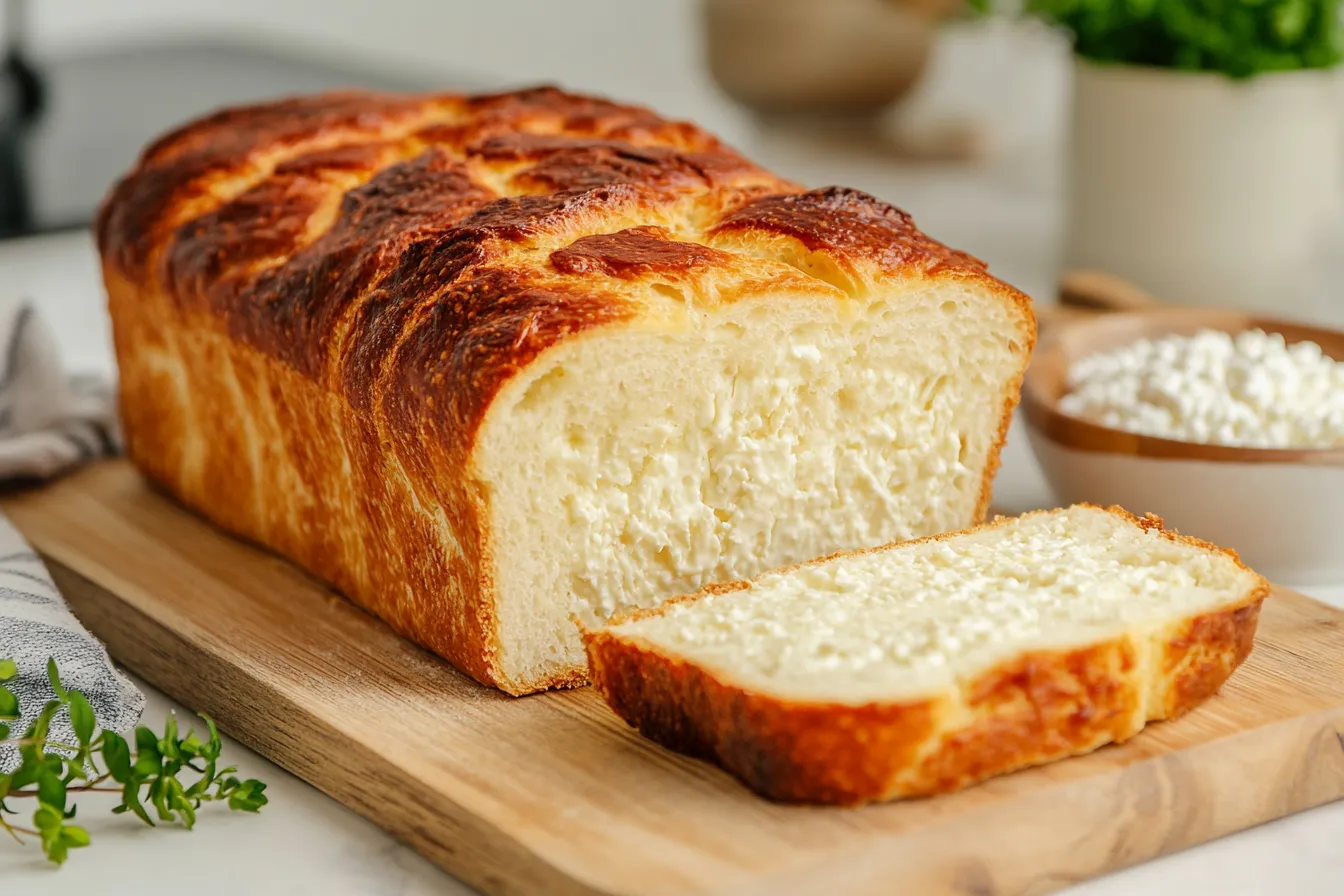Introduction
Cottage cheese bread is taking the internet by storm—and for good reason. This fluffy, protein-rich bread is not only delicious but also incredibly easy to make. With just a few wholesome ingredients like eggs, oats, and cottage cheese, you can whip up a loaf that’s low in carbs, high in nutrients, and perfect for everything from breakfast toast to sandwich layers. Whether you’re trying to eat healthier, follow a high-protein diet, or simply explore viral food trends, cottage cheese bread is the wholesome recipe you didn’t know you needed..Banana Oat Bars
This bread gained serious traction on platforms like TikTok and Instagram, where fitness lovers and food bloggers alike showcase their unique takes on the recipe. But beyond the trend lies a genuinely practical food—one that’s versatile, nutritious, and surprisingly filling. Plus, it’s beginner-friendly: you don’t need fancy flours, yeast, or kneading skills. If you have a blender and an oven, you’re halfway there.
In this guide, we’ll break down everything you need to know about cottage cheese bread: what it is, why it’s healthy, how to make it, and the best ways to use it in your daily meals. We’ll also bust some myths and offer expert-level baking tips to help you achieve the perfect texture and taste every time. By the end, you’ll have more than just a recipe—you’ll have a go-to favorite you can enjoy in countless ways.
What Is Cottage Cheese Bread?
Definition & Origin
Cottage cheese bread is a high-protein, low-carb bread alternative made primarily from blended cottage cheese, eggs, and a binding ingredient like oats, flour, or psyllium husk. Unlike traditional bread that relies on wheat flour and yeast, this bread skips the gluten and leavening agents, making it suitable for gluten-sensitive individuals and those following high-protein or low-carb diets like keto or paleo (with variations).
The base of this bread is simple: a soft curd cheese known for its high protein and low fat—cottage cheese. When blended and baked with the right ingredients, it creates a spongy, moist bread that mimics the texture of conventional loaves but with significantly better nutritional value..Cottage Cheese Banana Bread
Cottage cheese bread is not an entirely new concept; versions of it have been used in low-carb and weight-loss communities for years. However, its popularity surged when people began sharing their two-ingredient and three-ingredient variations online, emphasizing its convenience, affordability, and health benefits.
Viral Trend on Social Media (TikTok, Instagram)
What pushed cottage cheese bread into the spotlight was a wave of viral recipe videos on platforms like TikTok and Instagram Reels. Food influencers began showcasing how a simple blend of cottage cheese and oats could transform into a fluffy, golden-brown loaf. In most videos, the bread is sliced to reveal its airy interior, topped with avocado, peanut butter, or even used as a base for sandwiches. The combination of aesthetic visuals, health-focused ingredients, and ease of preparation made it a share-worthy sensation.
Several creators experimented with ingredients like chia seeds, egg whites, or Greek yogurt to put their spin on the recipe. Viewers responded with enthusiasm, especially those looking for smart substitutions for traditional bread that align with fitness goals. Searches for “cottage cheese bread recipe” skyrocketed on Google Trends, and Pinterest boards filled up with variations for weight-loss bread alternatives.
The virality also tapped into broader trends: high-protein eating, simple recipes for busy lives, and allergen-free cooking. As more people seek balance between health and indulgence, recipes like cottage cheese bread offer a middle ground. They’re functional, satisfying, and most importantly—delicious.
Whether you found the recipe through a social post or a friend’s recommendation, this bread is more than a passing fad. It’s becoming a staple for health-conscious home cooks.

Nutritional Advantages of Cottage Cheese Bread
High Protein Content
One of the biggest reasons cottage cheese bread has exploded in popularity is its protein content. Unlike traditional breads made with refined flour, cottage cheese bread delivers a hefty dose of high-quality protein in every slice. Depending on the specific recipe, a single serving can pack 8 to 15 grams of protein—comparable to a chicken breast or a couple of eggs..Carrot Cake Coffee Cake Recipe
Why does this matter? Protein plays a critical role in muscle repair, hormone production, and maintaining lean body mass. For people following fitness routines, weight-loss goals, or low-carb diets, protein is essential to keep energy high and cravings low. The protein in cottage cheese is predominantly casein, a slow-digesting form that keeps you full for longer—ideal for curbing snacking between meals.
Low Carb & Gluten-Free Benefits
For anyone following a low-carb lifestyle like keto, paleo, or Atkins, cottage cheese bread is a game-changer. Traditional breads are heavy on carbohydrates and can cause blood sugar spikes, but this alternative keeps carbs in check. Most recipes use either rolled oats, almond flour, or psyllium husk to add texture and binding without raising the carb count significantly.
Even better, this bread is naturally gluten-free when made without wheat-based ingredients. This makes it suitable for people with celiac disease, gluten sensitivity, or those who simply want to reduce inflammation and bloating caused by gluten-heavy foods.
Rich in Calcium & Micronutrients
Cottage cheese is also an excellent source of calcium, which supports bone health, muscle contraction, and nerve function. A single cup of cottage cheese can provide about 14% of your daily calcium needs. When incorporated into bread, it adds not just flavor and texture but also essential micronutrients like vitamin B12, phosphorus, and selenium.
These nutrients contribute to better metabolic function, cognitive support, and immune health. In fact, this bread can be a sneaky way to help picky eaters (including kids) get their daily dose of vitamins and minerals without reaching for supplements.
Satiety and Weight Loss Support
Let’s talk satiety—the feeling of fullness that helps you avoid overeating. Thanks to its protein, fiber (from oats or seeds), and moisture content, cottage cheese bread is highly satisfying. You’ll feel full faster and stay full longer, which is a major plus for anyone trying to manage their weight or eat more mindfully.
Unlike refined carb-heavy breads that lead to quick hunger rebound, cottage cheese bread digests slowly and releases energy over time. That means no sugar crashes or afternoon slumps—just steady fuel for your body and brain. Add some healthy fats or fiber-rich toppings like avocado or nut butter, and you’ve got a balanced meal in minutes.
Popular Cottage Cheese Bread Variations
Cottage cheese bread may start with a simple recipe, but there’s no shortage of delicious and creative ways to customize it. From minimalist two-ingredient versions to more hearty, nutrient-dense options, the flexibility of this bread makes it perfect for all kinds of eaters—from fitness enthusiasts to busy parents.
Flourless 2‑Ingredient Bread
For the ultimate quick-fix, you can make a version of cottage cheese bread using just two ingredients: cottage cheese and eggs. This minimalist recipe is great for those short on time or trying to avoid processed foods altogether.
Simply blend 1 cup of full-fat cottage cheese with 3 large eggs until smooth. Pour the mixture into a lined loaf pan and bake at 350°F (175°C) for about 30–35 minutes until golden brown and set. That’s it!
The result is a light, slightly eggy loaf that’s high in protein and low in carbs. While the texture may not be exactly like traditional bread, it works well as a base for savory toppings like mashed avocado, hummus, or smoked salmon.
Oat‑Based High‑Protein Loaf
Want something closer in structure to sandwich bread? Adding rolled oats or oat flour gives cottage cheese bread a more robust texture and adds a dose of soluble fiber, which is great for digestion.
Blend 1 cup cottage cheese, 2 eggs, and 1 cup rolled oats. You can also toss in 1 tsp of baking powder for lift and a pinch of salt. The oats absorb moisture during baking, giving the loaf a fluffy yet hearty consistency.
This version is ideal for breakfast or meal prep because it holds up well when toasted. Add a little cinnamon and stevia for a sweet version, or go savory with garlic powder, chili flakes, and herbs.
Seed‑Fortified or Flax/Oats Blend
For an ultra-nutritious loaf, many recipes incorporate ground flaxseeds, chia seeds, or psyllium husk. These ingredients boost the fiber content, improve the bread’s structure, and add subtle earthy flavors.
Here’s a basic version:
- 1 cup cottage cheese
- 2 eggs
- 1/4 cup ground flaxseeds
- 1/4 cup oat flour or almond flour
- 1 tsp baking powder
- Pinch of salt and optional spices
Bake for 35–40 minutes, and you’ll get a loaf that slices beautifully, stores well in the fridge, and offers incredible satiety.
Seeds like chia and flax are rich in omega-3 fatty acids, which support heart health and reduce inflammation. You can even sprinkle seeds on top of the loaf for texture and visual appeal.
Bonus Tip: Sweet vs. Savory Versions
Don’t hesitate to experiment. For a sweeter version, mix in banana, vanilla extract, or dried fruit. For a savory loaf, try sun-dried tomatoes, olives, spinach, or cheddar cheese.
This adaptability is what makes cottage cheese bread a staple: it fits your goals, flavor preferences, and time constraints.

Step-by-Step Cottage Cheese Bread Recipe
If you’re ready to dive in and bake your first loaf of cottage cheese bread, you’re in the right place. This step-by-step guide is designed for all skill levels and delivers a perfect balance of fluffiness, flavor, and nutrition.
Ingredients You’ll Need
This version strikes the perfect harmony between minimalism and quality. It’s not only easy to make but also uses ingredients you likely already have.
Basic Ingredients:
- 1 cup full-fat cottage cheese
- 2 large eggs
- 1 cup rolled oats (or oat flour)
- 1 tsp baking powder
- 1/2 tsp salt
- Optional: garlic powder, dried oregano, or chili flakes for a savory twist
- Optional: 1 tbsp olive oil for added moisture
Optional Add-ins:
- 1/4 cup grated cheddar or parmesan (for extra flavor)
- 2 tbsp chia or flax seeds (for extra fiber)
- 1 tbsp honey or maple syrup (for a lightly sweet touch)
This recipe yields one small loaf (approximately 6–8 slices), but feel free to double it if you’re meal-prepping or feeding a family.
Kitchen Tools & Prep Tips
Recommended Tools:
- Blender or food processor
- Mixing bowl (if not blending everything together)
- 8×4-inch loaf pan
- Parchment paper (optional but recommended)
- Cooling rack
Prep Tips:
- Drain excess liquid from cottage cheese before using. This helps avoid soggy bread.
- Use room temperature eggs for better blending and rise.
- Grease your loaf pan or line with parchment to prevent sticking.
Mixing, Baking & Cooling Process
Step 1: Blend the Base
Add cottage cheese, eggs, oats, baking powder, and salt into a blender or food processor. Blend until smooth and creamy—about 30 to 60 seconds. If you’re adding spices or cheese, toss them in at the end and pulse gently to combine without over-blending.
Step 2: Pour Into the Pan
Pour the batter into a greased or parchment-lined loaf pan. Use a spatula to smooth the top. If you like, sprinkle the top with sesame seeds, chia, or shredded cheese for texture and color.
Step 3: Bake
Bake at 350°F (175°C) for 35–40 minutes. It’s done when the top is golden and a toothpick inserted in the center comes out clean. If your loaf is browning too quickly on top, cover it loosely with foil for the last 10 minutes.
Step 4: Cool Before Slicing
Let the bread cool in the pan for 10 minutes. Then transfer it to a wire rack to cool completely. This step is crucial—cutting too early can cause it to crumble or become dense.
Step 5: Store & Reheat
Once cooled, store in an airtight container in the fridge for up to 5 days. To reheat, simply toast slices for 2–3 minutes. You can also freeze slices between parchment paper and pop them in the toaster directly from the freezer.
Quick Recipe Summary (For SEO & User Skim-Reading):
- Blend 1 cup cottage cheese, 2 eggs, 1 cup oats, 1 tsp baking powder, and spices.
- Pour into loaf pan.
- Bake at 350°F for 35–40 mins.
- Cool completely. Slice and enjoy!

Frequently Asked Questions (FAQ)
Is cottage cheese bread keto-friendly?
It can be! Traditional versions that use oats are not strictly keto due to their carbohydrate content. However, if you substitute oats with almond flour or coconut flour, you can easily create a low-carb, keto-friendly version of cottage cheese bread.
Can I freeze cottage cheese bread?
Yes, cottage cheese bread freezes beautifully. Slice the loaf, then wrap individual slices in parchment or freezer paper and store in a freezer bag. Toast slices straight from the freezer for a convenient breakfast or snack.
How long does it last in the fridge?
Cottage cheese bread stays fresh in the refrigerator for up to 5 days when stored in an airtight container. Make sure it’s completely cooled before storing to avoid moisture buildup.
Can I make it without eggs?
You can experiment with egg substitutes like flax eggs (1 tbsp flaxseed meal + 3 tbsp water per egg), though the texture may change. Eggs help with binding and moisture, so results may vary.
Which type of cottage cheese works best?
Full-fat cottage cheese provides the creamiest texture and richest flavor. However, low-fat or non-fat versions can also be used if you prefer a lighter option. Just be sure to drain any excess liquid.
Can I make a sweet version of cottage cheese bread?
Absolutely! Add cinnamon, vanilla extract, and a touch of honey or stevia to the batter. Top with fresh fruit or almond butter for a protein-rich sweet treat.
Conclusion
Cottage cheese bread is more than just a trending recipe—it’s a functional, nutritious, and delicious solution for modern lifestyles. Whether you’re looking for a low-carb bread alternative, a protein-packed snack, or a simple recipe you can customize endlessly, this bread ticks all the boxes.
With countless variations, freezer-friendly portions, and ingredients that support your health goals, it’s no surprise this loaf has gone viral. Try the classic oat-based version or experiment with flax, almond flour, or spices to make it your own.
So, next time you’re craving something comforting but clean, give cottage cheese bread a try. Your taste buds—and your body—will thank you.

Name: Cottage Cheese Bread
Ingredients
Equipment
Method
- Instructions:
- Preheat your oven to 350°F (175°C).
- Lightly grease or line a loaf pan with parchment paper.
- In a blender, combine cottage cheese, eggs, oats, baking powder, and salt. Blend until smooth.
- Add any optional ingredients (cheese, spices) and pulse a few times to combine.
- Pour the batter into the loaf pan and smooth the top with a spatula.
- Bake for 35–40 minutes or until the top is golden and a toothpick comes out clean.
- Let cool in the pan for 10 minutes, then transfer to a wire rack to cool fully before slicing.
